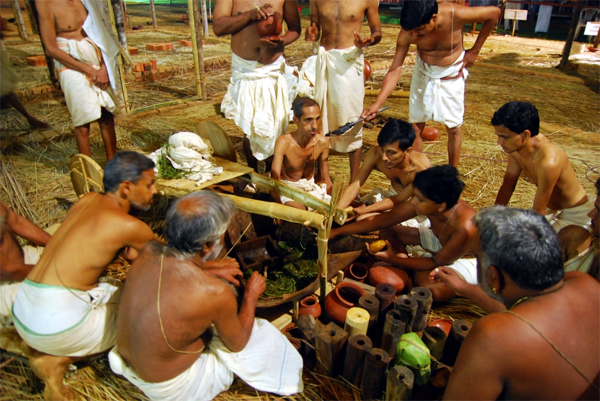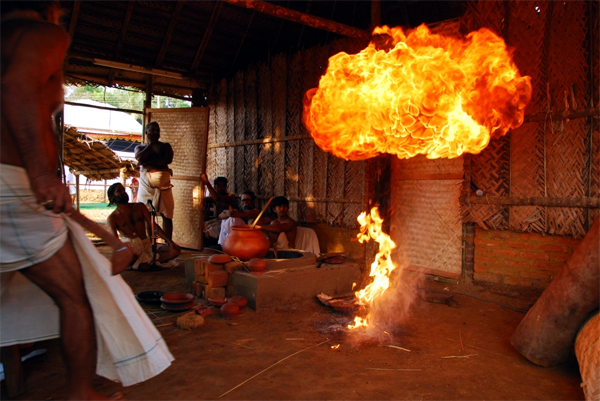Dec 29, 2025
Dec 29, 2025
The primal Vedic chants that ring across the rolling greens of this village in Thrissur district are a ceremonial invitation to Lord Indra, the god of rain, to join the ancient fire ritual of Athirathram.Towards the evening, thunder rumbles in the distance, almost as if Lord Indra is responding to the call of the 18 Vedic priests. And it rains. The priests have been chanting round-the-clock for the last three days to build up the energy level.

Panjal, 30 km from Thrissur town, was teeming with humanity on the 11th day of the ritual Thursday evening. For most tourists, it was a cultural and spiritual pilgrimage covering the Kerala Kala Mandalam, near the venue of the ritual, and the Guruvayoor temple in Thrissur district. The village of 32,000 people has drawn nearly 300,000 visitors in the last 10 days. The footfall is likely to touch 500,000 Friday when the sprawling 380-square metre venue is set afire to mark the end of the 12-day fire ritual for peace, purification, fertility, health and rain. It has been organised by a local non-profit group Varthathe Trust to revive dying Vedic traditions in the country.
Panjal is one of the key bastions of the 'Samavedis' and 'Rigvedis' - practitioners of the ancient Hindu scriptures Sama Veda and the Rig Veda - who have kept the two living traditions of Vedic chants and 'yagnya' (worship of elements) alive for nearly 4,000 years. Five families each of Rig Veda practitioners and Sama Veda practitioners preserve the tradition.
The village has played host to four major Athirathrams in 1901, 1918, 1956 and 1975.

In 1975, noted Dutch Indologist Frits Staal documented the ritual in a two-volume Vedic treatise -- "Agni: The Vedic Ritual of the Fire Altar". Staal, 81, who has returned this time, watched the proceedings from behind a barricaded enclosure. "Not much has changed. The ritual is alive and well. But it is a real pleasure to be back to Thrissur," he said.
A team from Harvard University led by professor Micheal Witzel is also studying the Sama Vedic chants. "It is one of the oldest living Vedic traditions and has not changed much," Witzel said. The ancient fire rite is an elaborate avatar of 'agnihotram' and 'somayaga' - fire worship and offering of the 'soma' rasa to the ritual fire - prescribed in the Vedas. It's said to symbolise the creation of the world with a ball of fire from the big bang, scientists studying the phenomenon say.
Athirathram is the most complex of the Vedic fire 'yagnas', first documented in 1100 BC and continued till 600 BC across the northern Indian river plains after which it disappeared from the northern part of the country. A Vedic community of Namboodiris Brahmins in south India, however, clung to it. "It combines chants and rites from the Rig Veda, Sama Veda and Yajur Veda," said Nellikaatilmamanul Vasudevan Namboodiri, one of the oldest Sama Veda practitioners of Panjal.
Yajamana Ramanujan Akkhithiripad, a priest from Chembra in Mallapuram district, presided over the rituals assisted by a team of 17 Vedic priests. Ramanujan's wife - known as the 'yajman pathni', has been camping at the 'yagshala' - the venue of the rite - for the 12 days with her husband as part of the rituals. The yajamana (presiding priest) and his wife carry the scared fire home in pots and keep it burning for the rest of their lives, Vasudevan Namboodiri said. At the heart of the ritual is the sacrificial fire that burns in a blaze of fragrant wood and herbal smoke. The ritual hearth resembles the white-crested red eagle found in the area.
"Sighting an eagle is a good omen," says priest Sivakaran Namboodiri. However, the ritual that generated maximum curiosity was the pressing of Soma stalks or 'somaabhishavam' on the 10th day to be offered as oblation to the fire god Agni. The 'soma' - an intoxicating creeper that grows in the Western Ghats - is ferried to the venue in special donkey-drawn 'soma' carts in a recreation of the Vedic era.
Over 300 women, decked as brides, partook of the special offering, 'soumyam, (prasadam)', a dish of clarified butter and rice -- for healthy childbirth and conjugal happiness. And an 'annaydanam (food offering)' kitchen fed 40,000 people everyday with traditional Kerala platters of ponni rice, poreal, avial, sambhar, pickles and payasam.
IANS
16-Apr-2011
More by : Madhusree Chatterjee